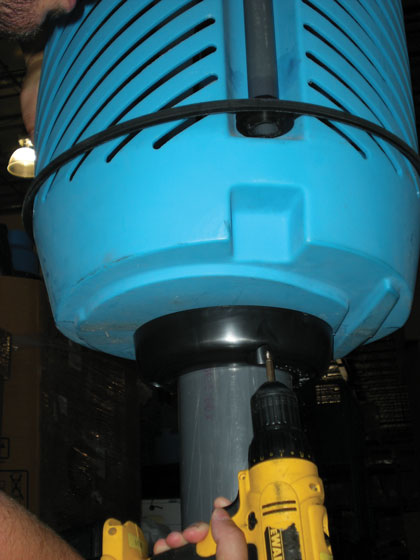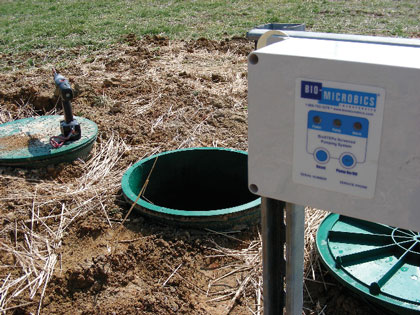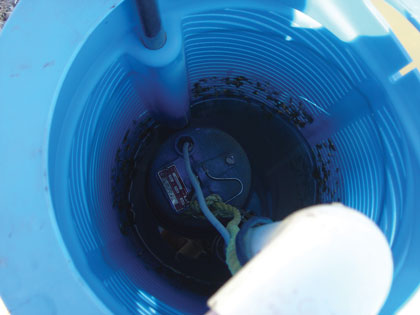When there are more options than to “hook-up” to a municipal plant and pay exorbitant connection fees, a community developer looks into alternative methods to handle water and wastewater issues for each/equivalent residential unit (ERU) on the property for development. Options include sump, sewage, grinder, gravity feed effluent, and filtered pump vaults commonly referred to as STEP (Septic Tank Effluent Pump).
THE NEW FACE OF WATER UTILITIES
As part of a progressive replacement program, municipalities will continue to develop and install innovative technology, prescreening / pretreatment systems and better maintenance procedures. The challenge many strong industries within the economy face are to understand what technologies are available and will they work on their site to improve their wastewater treatment facilities. The investment seems high upfront, but the payoff is significant overtime with reduced maintenance and operation costs.
The water utility business model is changing. Historically, water and wastewater utilities have functioned as monopolies without competition. As the price of water services rises, the cost of new technology drops, and concern for securing a water supply increases, we are likely to see a rise in use of these “disruptive” technologies, which can undermine the monopolistic nature of the water utility.
Now technological advances are allowing more options for water efficiency, water re-use, and water harvest.

Installation of adjustable footing to handle weight of the submersible pump.
WHAT TO DO?
Small municipalities can explore the option of updating their wastewater facilities. And those public/private that do not have the resources for a large infusion of cash to update these facilities might consider outsourcing to treatment facilities that already have this technology in place.
A STEP system prescreens wastewater from large solids and inorganic clogging debris; and is a form of pressure sewer that has several advantages over traditional gravity collection systems. As an ideal conveyance method where gravity collection systems are not possible, the STEP system includes a holding tank for sewage, a screen chamber, and a small, high-pressure pump within the tank. The STEP system pump is controlled by a system of floats within your tank. The floats activate an alarm in the electrical (alarm) box when the fluid level in the tank gets too high or too low. The liquid waste is pumped through a small pressure line into sewer lines.

Provides flexible, uniform installation options for most tank, manhole, and riser configurations.
THE PATH TO RESPONSIBLE WATER USE
STEP units encourage responsible water use and disposal practices by the homeowner. As a cost effective solution for transporting effluent in a wastewater collection and treatment system, STEP effluent quality (average TSS 29, BOD5 129) is much better than sewage, reducing the biological load. The quality of effluent from STEP Units allows the collection system to be designed the same way as a water system. Small diameter PVC pipe is laid in shallow trenches. Infiltration problems are eliminated, and hence, treatment plants can be smaller; lift stations and manholes are not required. Maintenance and operating costs are the same as, or less than, conventional sewers. Per -unit costs can be much lower, especially in areas with dispersed dwellings, hilly terrain, high water table or rock. The on-site costs can be deferred until occupancy.
Available from Bio-Microbics, Inc., the BioSTEP® (Septic Tank Effluent Pumping) Systems are ideally suited for all onsite wastewater pumping applications, from single family residential to small diameter collection systems. These effluent pumping systems filter out solids so that only liquid from the “clear zone” between the tank’s scum and sludge layers is pumped. This reduces biological loading and clogging of downstream components, extending drainfield life. All systems are pre-assembled with corrosion resistant, durable components, ensuring reliability. All BioSTEP Systems are available as individual components or preassembled in ready-to-install System Packages. Our Filtered Pump Vaults provide your pump with critical protection from solids larger than 1/16 inches (1.59 millimeters) Each vault incorporates slotted filter screens into easily removable panels, allowing for an easy and quick servicing.

BioSTEP’s standard design incorporates a superior 3/4 inch (19.05 millimeter) solids handling sewage pump and a comprehensive control system.
COSTS, INSTALLATION, OPERATION AND MAINTENANCE
The cost of a STEP/STEG system can be divided into two major components: The on-lot cost and the collection network cost. On-lot installation costs include the pump, tank, controls, building sewer, and electrical service. A STEG system would not have the pump, controls and electric service costs. The initial on-lot costs are usually paid by the lot owner. The installer must follow the guidelines established by the utility for the selection and placement of components. Depending on the style of pump and tank selected by the utility, and the STEP pressure requirements needed to inject sewage into the network, the on-lot costs are estimated to be $3500 to $5000 for a single-family home. The electrical cost would be about thirty dollars per year.
Licensing requirements for personnel who install STEP/STEG systems varies, but they must typically be licensed by the state or region in which they work. Like all other alternative collection systems STEP collection network require minimum excavation. The required depth of the pipeline is minimal and can generally follow the terrain. The collection network is installed either through trenching or horizontal directional drilling (HDD). HDD reduces or eliminates the need for large, deep trenches that disrupt existing utilities, landscaping, roads and driveways. STEG systems must maintain an overall slope toward a lift station or treatment facility. However, since there are no heavy sewage solids to be transported, slope can be significantly reduced or eliminated. In all cases, slope and sewage velocity requirements are less than a conventional gravity sewer. Many small communities have both STEP and STEG within the same cluster of sources.

Once installed, BioSTEP STEP/STEG devices are designed to be cleaned in place—no removal of any components.
DESIGN, CONSTRUCTION, AND INSPECTION
Effective operation of a STEP/STEG system begins with proper design and construction, but regular inspection of system components is critical. Leaky tanks or pipe connections are a potential source of groundwater infiltration that can overload the system’s capacity. Tank residuals must be pumped out on a requisite basis (ideally, when solids are 25 to 33 percent of the liquid depth of the tank) and effluent screens (in STEG tanks) must be inspected annually and cleaned as needed. Service providers must be properly trained and have knowledge and skills related to effluent screens, electrical connections and controls and other sewer appurtenance technologies. They must know and observe the associated safety precautions. Operators must have proper training and may be subject to certification requirements depending upon jurisdiction.
If pumps in STEP configurations are installed with quick-disconnect fittings, maintenance is facilitated and replacement costs are reduced. System components should be standardized as much as possible to facilitate easy maintenance. Some wastewater sources may need more powerful pumps if they are located at lower elevations or at distant sites. When these special pumps fail, they must be replaced with pumps of similar capacity.
Typically, preventive maintenance visits are required for the on-lot components as well as the communal collection components. Historically, STEP unit service callouts are overwhelmingly related to electrical/control issues. With STEG systems, effluent screens should be checked annually and cleaned as needed. ■
About The Author
Jennifer Cisneros is the manager of marketing and multimedia for Bio-Microbics, Inc. Bio-Microbics has developed a number of innovative products, some of which have revolutionized methods of dealing with the treatment of sewage on sites where infrastructure and drainage was and is not available. For more information, visit www.biomicrobics.com.
MODERN PUMPING TODAY, March 2015
Did you enjoy this article?
Subscribe to the FREE Digital Edition of Modern Pumping Today Magazine!
![]()


